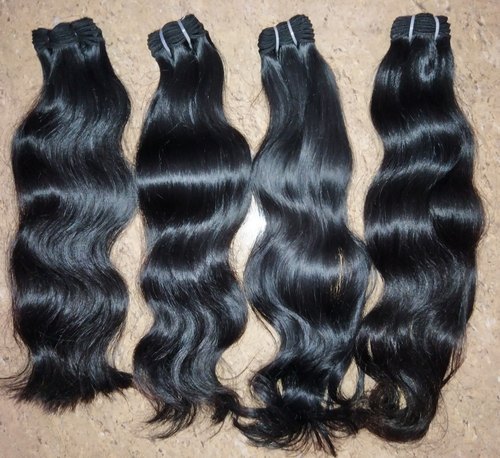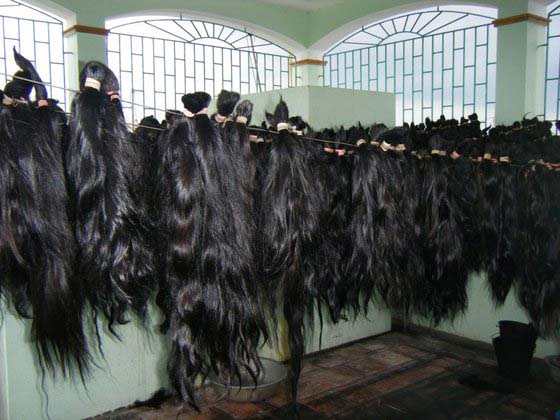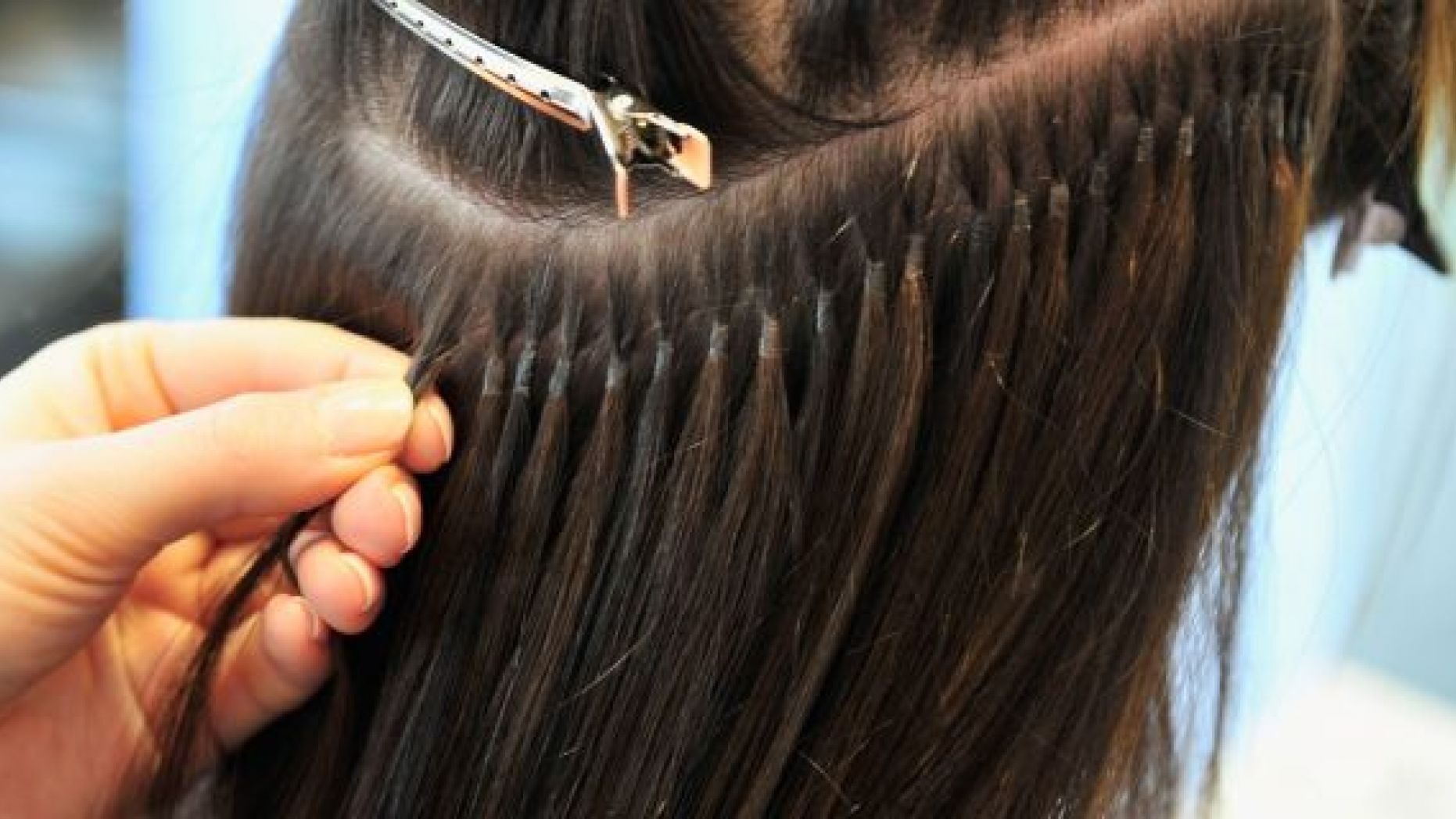Every day, thousands of devout Hindus make pilgrimages to Tirumala Venkateswara Temple in India. As an act of gratitude and sacrifice, they shave/tonsure their heads as a sign of respect.

Temples in India are a major source of hair for wig and extension manufacturers. They also sell it to industrial companies that use it for stuffing mattresses, creating oil filters or extracting amino acids from it.
Pilgrims donate their hair
As a symbol of devotion, many Indian women and men donate their hair at temples across the country as an act of charity. This ancient ritual earns temples millions of dollars every year. Barbers shave off the hair in front of an eager audience of devout pilgrims in large rooms filled with dedicated staff members.
Shaved hair is collected into a large basket and transported to an expansive warehouse, where it awaits the next wave of donors. Successful auctions are organized by the temple’s head priests who sell the locks to wholesalers at an average rate of $350 per pound.
For over 2,000 years, Tirupati Balaji temple has been a landmark destination in Southeastern India for those interested in Hinduism or spirituality. Notable visitors include high-profile individuals as well as tens of thousands of devotees who pass through its doors annually with different spiritual beliefs. While the complex facilities and offerings may be impressive, none compare to the hair cutting ritual conducted there – according to TTD research – which offers visitors an unique experience compared to other locations.
The hair is shaved
At Venkateshwara temple in Tirupati, India, devotees offer their hair as a sacrifice to their gods as an act of gratitude for all the blessings bestowed upon them. This act is known as tonsure and serves to demonstrate gratitude for what blessings have been bestowed upon them.
Devotees wait in line for hours, often longer on festival days, to offer their hair in a ceremony steeped in Hindu tradition and devotion. Every six hours the locks are collected into baskets and stored at an expansive warehouse where it lies knee deep.
Women donating their hair are given a small sachet of sandalwood paste to apply on their scalps after shaving. It is believed to ward off evil spirits and bring luck.



Once the pilgrims are ready, they sit cross-legged on the floor and lean forward to allow a temple barber to shave them. The freshly shaved hair is then scooped up by women workers and smeared with paste.
At the conclusion of each session, shaved hair is rinsed away with water and sold to vendors in western countries through online auctions that bring in between $3-6 million annually for the temple.
Some of the hair is sold to wigmakers, while other pieces are processed and exported for fashion industry hair extensions. One leading manufacturer boasts that countless celebrities in Europe and America have used its products.
Many donors boast long, dark locks. These strands are the highest priced and most sought after, accounting for a quarter of global hair trade.
Shaved hair is processed at processing plants and exported around the world; some of the longest can be sold for up to PS350 per pound.
Indian temple human hair is exported to wigmakers around the world. According to Balsara, an international supplier of temple hair, one ton of donated temple hair is worth as much as donations from around 3,000 women.
Hair is also sold to cosmetic manufacturers who extract l-cysteine from it, an amino acid manufactured through hydrolysis. This amino acid is widely used in skin care products and has numerous health benefits.
The hair is sold
Many non-Hindus may not know this, but the hair found in salons around the world comes from temples across India. Pilgrims donate their locks as part of a spiritual ritual known as tonsuring; every six hours, temple barbers shave off each pilgrim’s head and collect baskets full of donated locks in an immense warehouse.
When the shaved hair is sold, it typically goes to two markets: companies making fertilizers and chemicals; or those creating wigs and extensions. The most lucrative hair comes from female pilgrims and is sold at auction for a premium.
Temple workers take care of getting the best hair by untangling strands that have become entangled, picking out lice and other particles, washing it dry, then dying it in various colors. After that, they ship these healthy strands off to factories in China or Hong Kong for processing.
Once they arrive, the hair is separated by length and grade before being sent off to either a factory or salon where stylists sew, tape or bond it into their customers’ hair or create a wig. This process is repeated until the finished product is ready for sale.
One thing is certain about the human hair trade: it can be a dirty business. Sweat and blood, plus food particles and lice, come dripping from the long strands collected here. Throw in an unpleasant odour into the mix, and it’s no wonder why people in the temples often grimace.
Temples can make a substantial profit by collecting this hair and cultivating it into an lucrative industry. Tirumala Venkateswara’s locks alone bring in an estimated $17 million annually.
Temple administrators typically receive a large portion of that money for charity and other projects within their community. They assure us that we aren’t pocketing it; rather, it goes towards funding medical aid projects and infrastructure upgrades.
Aside from temples, other hair-merchants go door-to-door to collect what’s known as “fallen hair,” which refers to random strands pulled from people’s combs or brushes. These strands are then combined and processed into a lower quality extension.
The hair is shipped
Hair has seen a meteoric rise, with imports reaching $700 million in 2016. Temples offer the ideal location to harvest and sell strands of shiny, golden, or tangled beauty to those with the means and the sexiest dispositions. For those with money to spare or who possess the most seductive tastes, one kilo can be purchased for an enticing sum.
The challenge lies in getting it where it needs to go. A team of highly-trained professionals does the hard work, searching the world for superior quality with a good heart and delivering it right to your door. Not only that, they ensure each bundle has the appropriate girth and luster as well as checking that hair is in top condition – an undertaking which takes both time and money.
Hair extension companies come in a wide variety of styles and textures, but we’ve chosen one that will stand by you in the long run. Not only are they an established source for high quality human hair but they offer excellent customer service and free shipping too. Some of their most impressive benefits include being able to order large amounts without breaking your budget, an extensive selection of textures, and an amazingly quick turnaround time.
